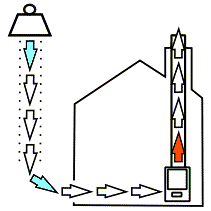

|
|
|
|
THE CHIMNEY EFFECT A chimney is not a mere duct to carry away smoke, but the 'engine' which makes a solid fuel fire work. If the chimney isn't right, you'll get.. ● Dangerous smoke emissions to the room ● Slow lighting, poor performance ● Difficulty in burning for extended periods ● Tar and soot deposits ● Excess smoke emission from the chimney ● Lack of control Understanding how chimneys work is central to understanding stoves and fireplaces and to solving problems. This page explains the physics of chimneys, for information about building, repairing and inspecting chimneys, look at the Installation page.  If the chimney is not appropriate, it will not generate enough upward draught, not enough air will be sucked in towards the fuel for it to burn adequately, and smoke will not be properly evacuated. Most closed stoves need an upward draught of about 12Pascals, or 0.05insWG, measured using a draught meter or 'micromanometer'. This is especially so with modern stoves which usually achieve high efficiency by having flueways or restrictive baffles designed to prevent hot gases from leaving the stove quickly. Although a chimney appears to 'suck' and smoke appears to naturally rise, it is more accurate to think of the weight of dense outside air pushing down to force air into the building, into the fire and so push the hotter, lighter, waste gases out up the stack, somewhat like an air bubble rises in water. This 'Chimney Effect' generates the 'draught' (or draft), the very tiny difference in pressure inside and outside the flue. Predicting flue draught from the chimney design is very difficult - there is an algorithm in EN13384 (Chimneys - Thermal and fluid dynamic calculation methods), but it is extremely complicated. Draught can roughly be predicted from; Where: ΔP = The pressure difference (draught) in Pascals Tc = Average chimney flue internal temperature, °C Ta = Ambient (outside) temperature, °C h = The chimney height in metres. In practice, how strong the draught is depends on four things: HEAT inside the chimney. The gases inside the chimney must stay VERY hot, or they will not rise. Although a small length (up to about 1m) of uninsulated flue pipe may be acceptable directly from a stove, the entire length of the chimney above must be insulated, typically by thick masonry around an insulated ceramic liner or using prefabricated insulated components. Large voids inside the flue mean a large area of masonry to cool down the gases, especially if their outer surface is outside the building and exposed to the cold. Efficient modern stoves release less heat into the flue and need especially strict attention to the chimney. HEIGHT of the chimney - the higher it is, the more draught will be generated. For typical domestic chimneys and appliances in Britain and Ireland both the British Standard (BS 8303-1:1994) and Document J suggest a height of about 4.7 metres of straight, smooth, insulated chimney above the appliance. Less than perfectly sound chimneys will need to be taller to compensate. Special rules apply to Open Fires. ROUTE - The entire route from fire to chimney terminal needs to be smooth, straight and vertical wherever possible. Where bends absolutely cannot be avoided, they should be very gentle (say a maximum of 2x 45º) and the chimney height increased by at least a metre to compensate. The flue needs to be absolutely sealed, without the slightest tiny crack at any point which might let cool air in. The flue needs to be big enough for the appliance being used - BS 8303 suggests a minimum of 125mm diameter for closed appliance up to 20 kW rated output (150 mm if burning smoky fuels) - but not so big that its large surface area will cool the smoke (say, bigger than about 375mm square). Special rules apply to open fires. AIR SUPPLY - There needs to a route by which outside air can enter to replace the volume being lost up the chimney. While this can sometimes be provided by air leaking in through doors, windows etc., it is often necessary to fit a purpose-made air vent. An extractor fan, or another fuel-using appliance, even in a different room, can remove this air. |
|
MORE FROM Soliftec... Home ● Fuel Costs ● Installation ● Library ● About ● Air Supply ● Blogspot ● Building Rules ● Carbon Monoxide ● CE Marking ● Dictionary ● Efficiency ● Electricity - CHP ● Embodied Energy ● Fascinating Facts ● Fireplace Doctor ● Fuel Properties ● Heat Need ● Heroes ● Legislation ● Manufacturers ● Open Fires ● Smoke ● Solid Fuels ● Standards ● Statistics ● Stove History ● Tables, Data and Formulas ● Test Laboratories ● Thatched Roofs ● The Carbon Cycle ● The Chimney Effect ● Wood Fuel ● Email: info@soliftec.com COPYRIGHT and ALL RIGHTS RESERVED: © Soliftec Ltd, Thursday 19 December 2019 BUILT WITH WHIMBERRY matrixstats |